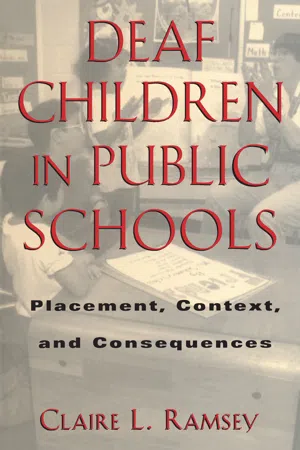
Sociolinguistics in Deaf Communities
Placement, Context, and Consequences
- English
- PDF
- Available on iOS & Android
About This Book
As the practice of mainstreaming deaf and hard of hearing children into general classrooms continues to proliferate, the performances of these students becomes critical. Deaf Children in Public Schools assesses the progress of three second-grade deaf students to demonstrate the importance of placement, context, and language in their development. Ramsey points out that these deaf children were placed in two different environments, with the general population of hearing students, and separately with other deaf and hard of hearing children. Her incisive study reveals that although both settings were ostensibly educational, inclusion in the general population was done to comply with the law, not to establish specific goals for the deaf children. In contrast, self-contained classes for deaf and hard of hearing children were designed especially to concentrate upon their particular learning needs. Deaf Children in Public Schools also demonstrates that the key educational element of language development cannot be achieved in a social vacuum, which deaf children face in the real isolation of the mainstream classroom. Based upon these insights, Deaf Children in Public Schools follows the deaf students in school to consider three questions regarding the merit of language study without social interaction or cultural access, the meaning of context in relation to their educational success, and the benefits of the perception of the setting as the context rather than as a place. The intricate answers found in this cohesive book offer educators, scholars, and parents a remarkable stage for assessing and enhancing the educational context for the deaf children within their purview.
Frequently asked questions
Information
Table of contents
- Contents
- Editorial Advisory Board
- Editor’s Introduction
- Preface
- Chapter One: Deaf Children and Appropriate Contexts for Education
- Chapter Two: Aspen School: The Players, the Plan, the Analysis
- Chapter Three: Placements and Contexts: What Is a Public School Deaf and Hard of Hearing Program?
- Chapter Four: Mainstreaming at Aspen School
- Chapter Five: Peer Interaction and Communication in the Least Restrictive Environment
- Chapter Six: The Self-Contained Classroom at Aspen School
- Chapter Seven: Placements, Contexts, and Consequences
- References
- Index